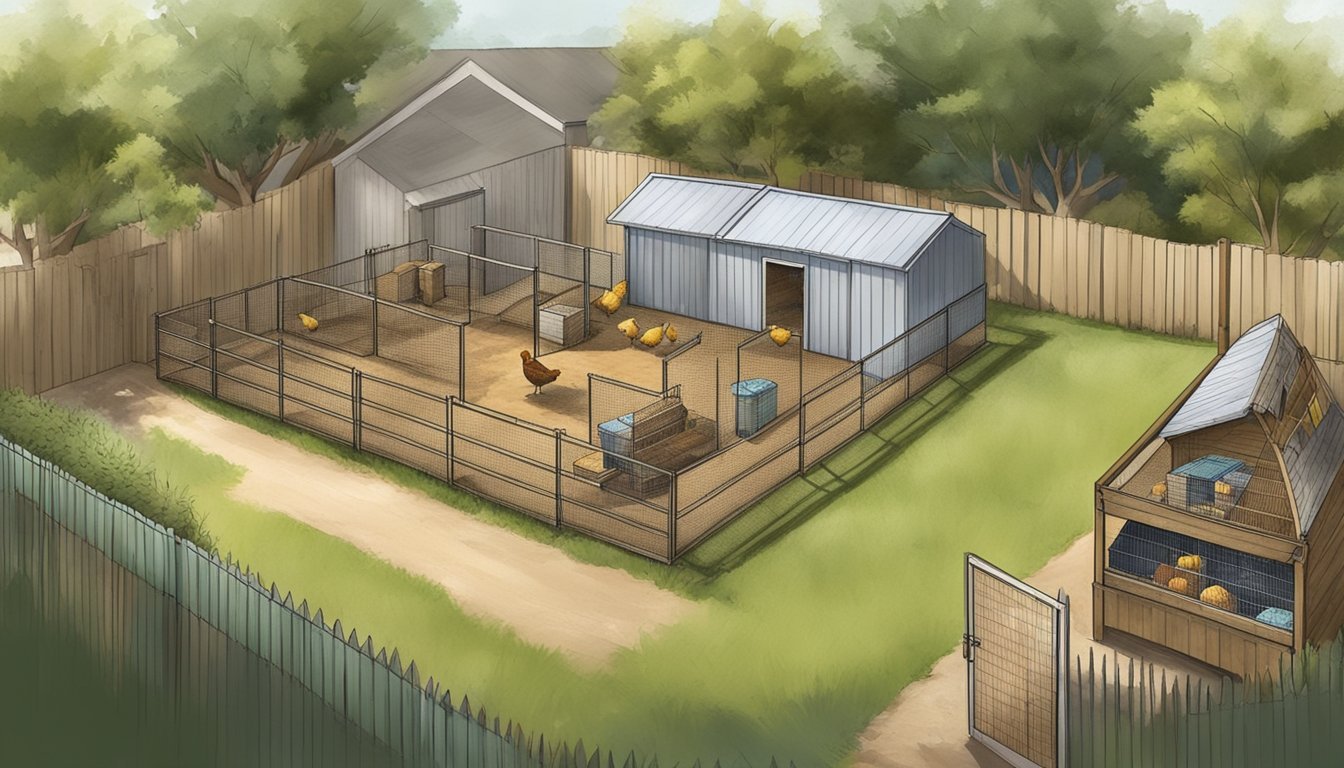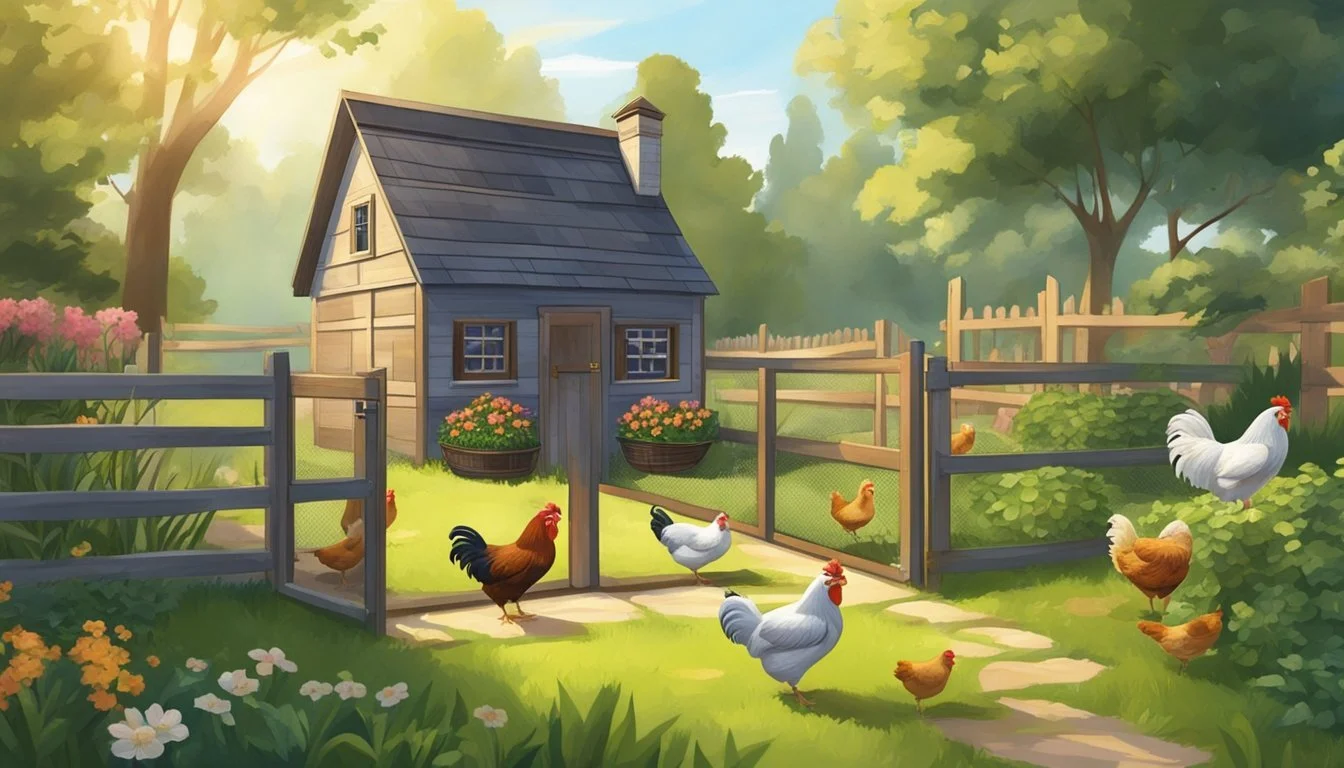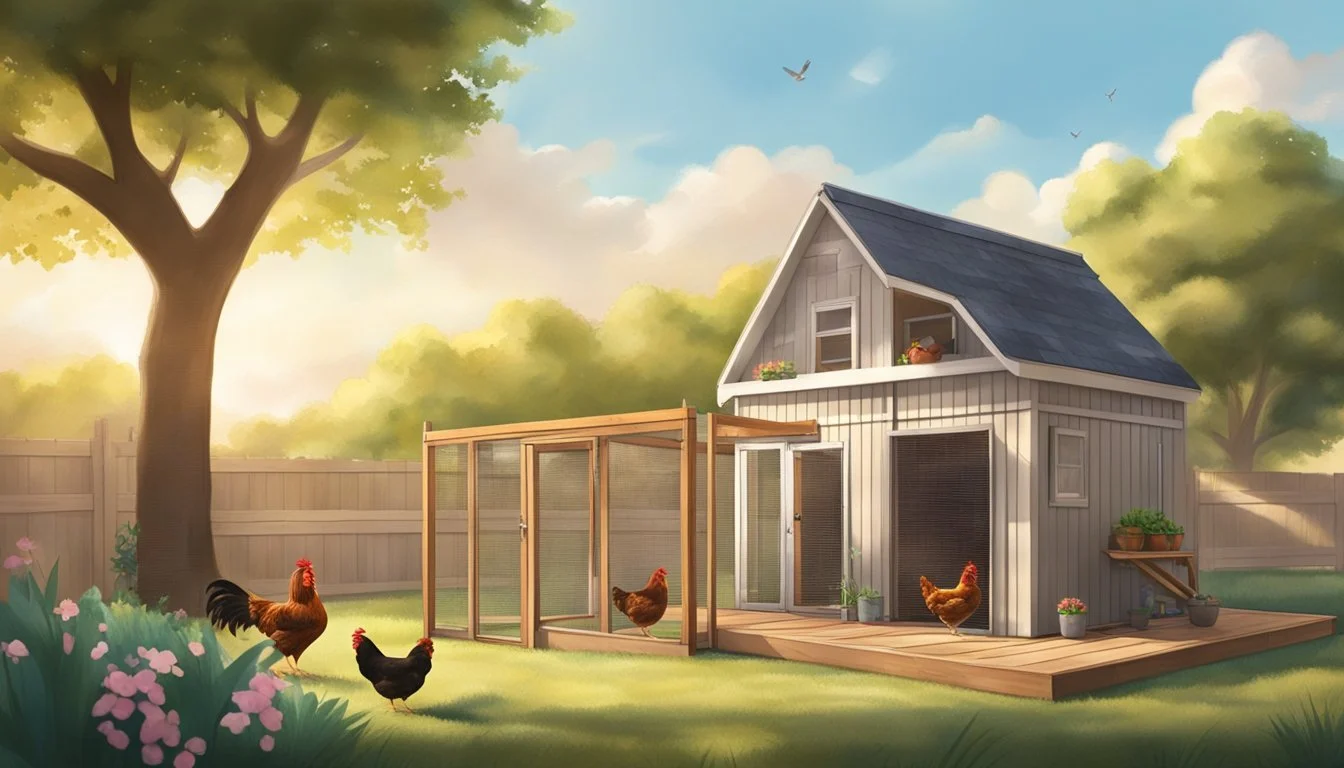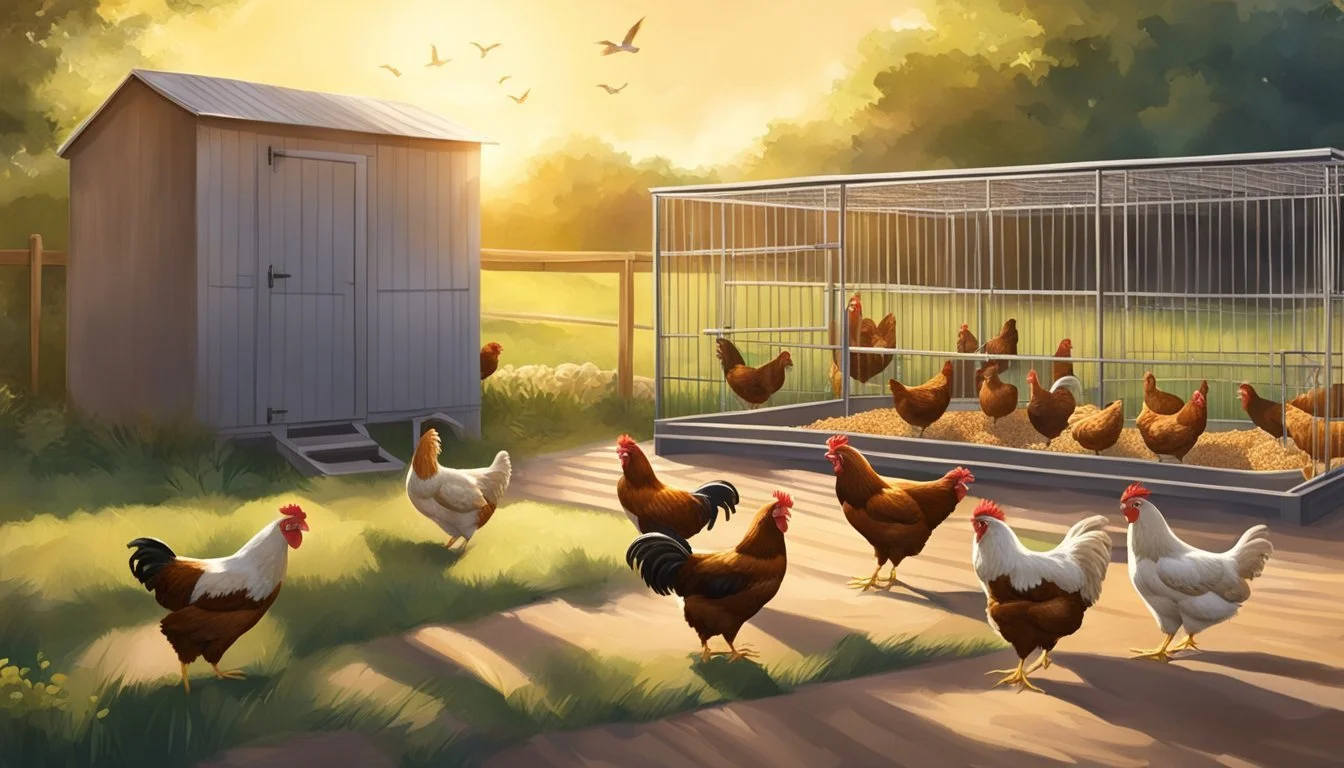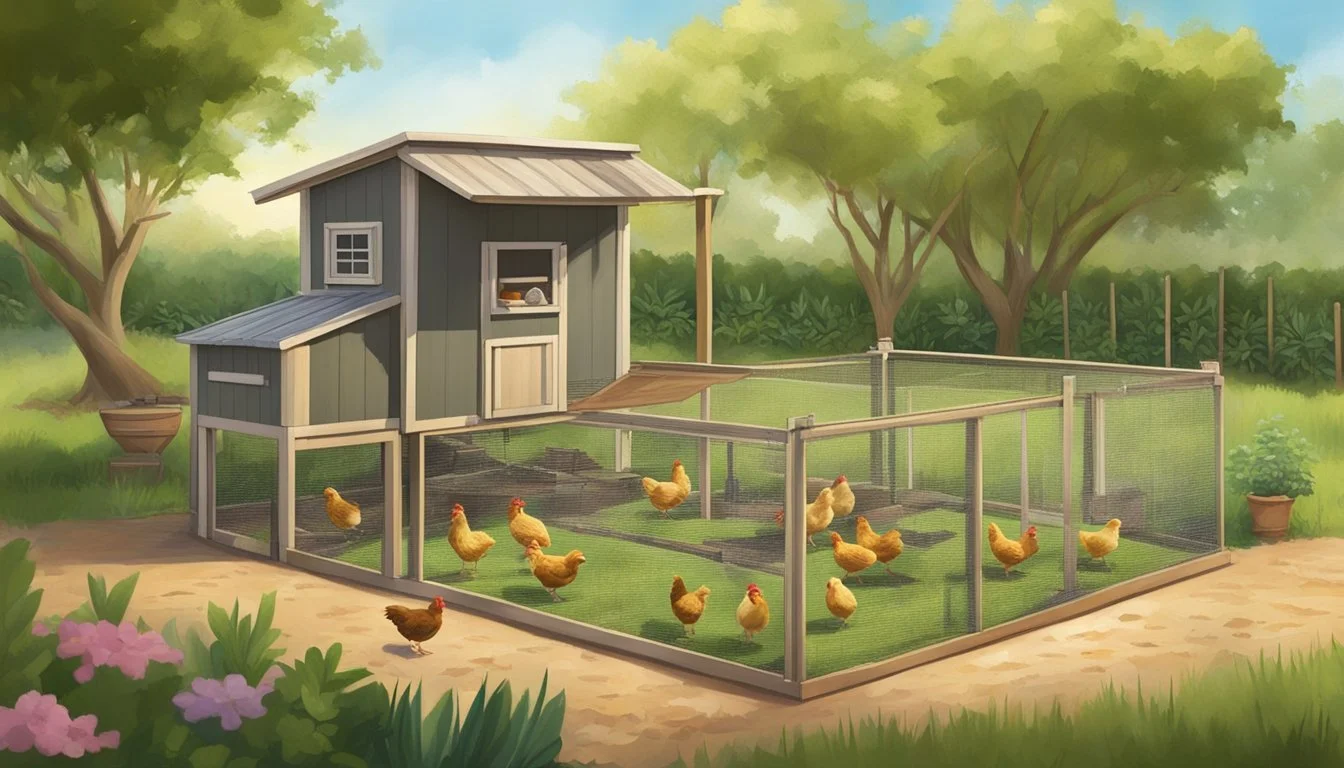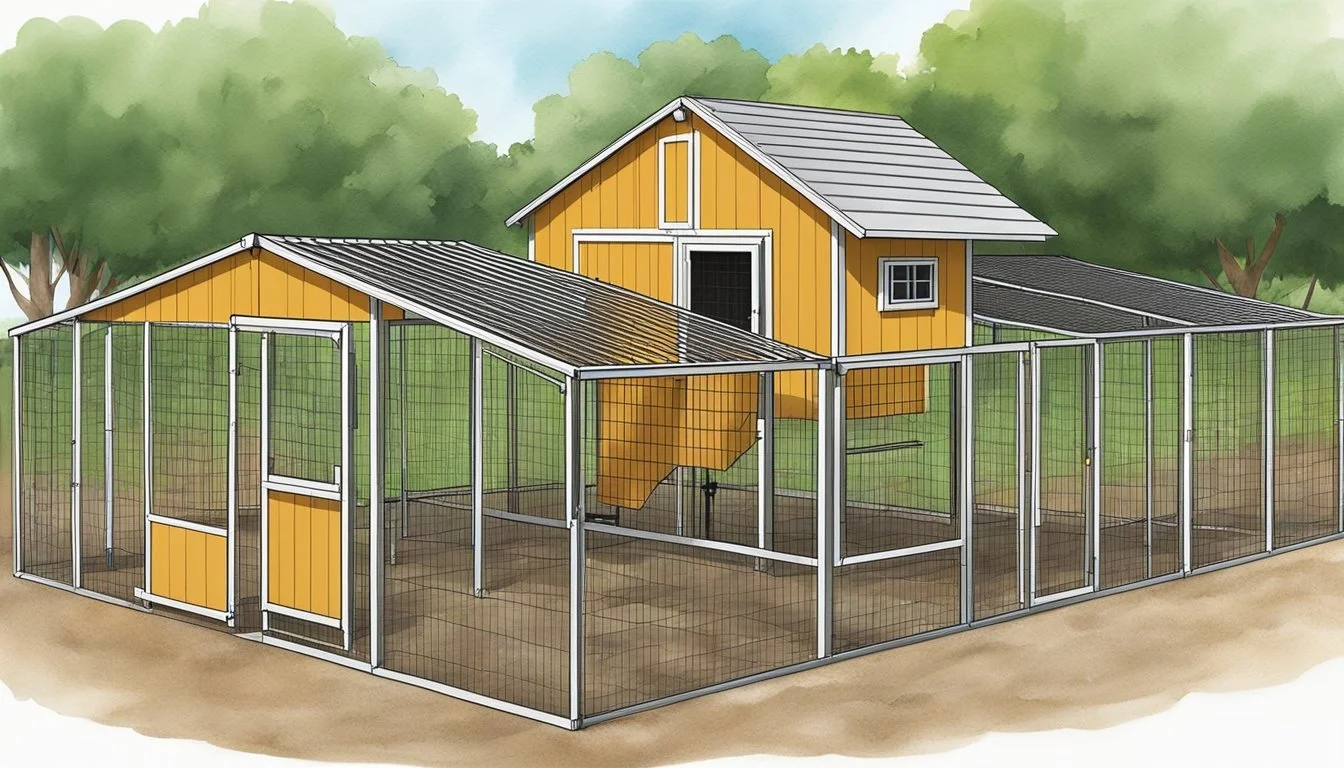Raising Backyard Chickens in Pharr, TX
Your Essential Guide to Urban Poultry
Raising backyard chickens in Pharr, TX, is a practical activity for those interested in producing their own fresh eggs, practicing urban agriculture, or simply seeking the companionship of these domesticated fowl. The city of Pharr has specific ordinances that ensure the proper maintenance and housing of chickens to maintain a harmonious residential environment. To comply with local law, residents must keep roosters and chickens in cages or pens and must see that these enclosures are kept in a clean, safe, and sanitary condition.
The trend of backyard chicken-keeping offers numerous benefits including access to eggs with potentially higher nutritional value than store-bought options and the enjoyment of chickens as pets with their unique personalities. Understanding the life cycle of chickens is crucial for raising them successfully; they typically begin laying eggs at the age of five to six months and can provide a substantial quantity of eggs throughout the year.
Prior to embarking on this venture, potential chicken owners in Pharr must be well-informed about the city's maximum limit on the number of fowl allowed, which ensures that each chicken has adequate space and resources. Embracing these guidelines contributes to the wellbeing of the chickens and the satisfaction of their caretakers, making the prospect of raising backyard chickens in Pharr a fulfilling and responsible pursuit.
Understanding Local Ordinances and Regulations
When raising backyard chickens in Pharr, Texas, it is crucial to understand the specific local ordinances and regulations to ensure compliance.
Residential Zoning and Chicken Ordinances
Local authorities in Pharr have established zoning laws that dictate whether residents can keep chickens based on their property's zoning district. It is important for residents to verify their zone's classification and adhere to any local ordinances that apply to the keeping of domestic fowl within these areas.
Limits on Flock Size and Restrictions
Pharr's chicken ordinance stipulates clear guidelines regarding the number of chickens allowed:
Maximum of domesticated fowl allowed
Enclosure requirements (cages or pens)
Maintenance standards (clean, safe, and sanitary conditions)
Residents need to follow these local chicken laws to avoid penalties.
Penalties for Non-Compliance
Non-compliance with the chicken ordinance can result in fines or other penalties. Individuals maintaining flocks that exceed the permitted limits or fail to meet enclosure standards may face actions enforced by the local authorities. It is critical to remain up-to-date with any amendments to the local ordinances to avoid such fines.
Selecting the Right Chicken Breeds
Choosing the right chicken breeds for backyard farming in Pharr, TX, entails deciding based on their purpose—egg laying or meat production, adaptability to Texas climate, and understanding their behaviors and space needs.
Egg-Laying vs. Meat Breeds
In Pharr, backyard poultry keepers typically prioritize breeds based on whether they are interested in egg production or meat. Rhode Island Reds are renowned for their robust brown eggs and dual-purpose utility, often laying over 300 eggs per year. Leghorns are another popular choice, particularly for high volume white egg production. On the meat side, breeds like Cornish Cross are favored for their rapid growth and substantial meat yield.
Egg-laying breeds in Pharr include:
Rhode Island Reds
Leghorns
Sussex
Meat breeds suitable for Pharr include:
Cornish Cross
Jersey Giants
Climate-Adapted Breeds for Texas
Pharr, Texas, experiences hot summers, so chickens that fare well in heat are a necessity. Breeds known for their heat tolerance, such as Andalusians and Leghorns, can be suitable. These breeds have larger combs and wattles, which help dissipate heat. Conversely, thick-feathered breeds often struggle with Texas heat and may be prone to heat stress.
Breeds well-adapted to hot Texas climates include:
Andalusians
Leghorns
Sussex
Personality and Space Requirements
Chickens require adequate space for health and well-being. Standard chickens need about 4 square feet inside the coop and 10 square feet in the run per bird. Roosters require more space to prevent aggressive behavior. Personalities differ among breeds; Rhode Island Reds are often friendly and curious, while Leghorns are more active and flighty, making them less suitable for confined spaces.
Space requirements for chickens in Pharr:
Coop: At least 4 sq. ft. per chicken
Run: At least 10 sq. ft. per chicken
Personality traits of common breeds:
Rhode Island Reds: friendly, curious
Leghorns: active, flighty
Creating the Perfect Chicken Coop
In Pharr, TX, where the climate and local fauna present unique challenges, designing the perfect chicken coop requires careful consideration. Safety, comfort, and adequate space are essential to ensure healthy and productive backyard chickens.
Designing for Safety and Comfort
One prioritizes a design that shields chickens from extreme weather and predators. A sturdy structure, strong locks, and hardware cloth instead of chicken wire can be the difference between safety and vulnerability. The coop should be built on elevated ground to avoid flooding during heavy rains, which are common in Pharr, TX.
Protection from Predators:
Walls: Solid, using hardware cloth buried at least 12 inches underground
Doors: Equipped with high-quality locks
Roof: Solid, to stop climbing predators and protect from harsh sun
Essential Features of a Coop
An ideal coop is more than just a shelter—it's a home that caters to the chickens' natural behaviors. Nesting boxes, perches, and an easily accessible feed and water area are non-negotiable.
Nesting Boxes: Minimum one box for every three to four hens
Perches: Adequate space for all chickens to roost comfortably at night
Accessibility: For easy cleaning, egg collection, and chicken care
Space and Ventilation Considerations
Chickens need space not only to roam but also to breathe. The coop should provide at least 3-4 square feet per chicken inside and 8-10 square feet per chicken in an outdoor run. Good ventilation is key to removing dampness and ammonia, so designing with ample airflow without creating drafts is crucial.
Ventilation:
Windows or vents are positioned above the chickens' heads when they are roosting
Adjustable venting to accommodate temperature changes throughout the year
By focusing on these aspects, one creates a coop that serves as a safe and comfortable haven for backyard chickens in Pharr, TX.
The Chicken Run: Outdoor Space Management
Maintaining a well-structured chicken run is essential for the health and safety of backyard chickens. Proper sizing and security are vital to protect the flock, while cleanliness is critical to prevent disease.
Size and Security Features
The size of the chicken run in Pharr, TX, is crucial for the wellbeing of the chickens. According to local ordinances, every bird should have enough space to move freely, and this typically means allocating at least 10 square feet of outdoor run area per chicken. This space allows them to exhibit natural behaviors such as scratching, pecking, and dust bathing.
Security features of a chicken run must include:
Fencing: High enough to prevent chickens from flying out and sturdy to deter predators.
Cover: Either solid roofing or mesh to offer protection from birds of prey.
Lockable Gates: To safeguard against unauthorized access and potential predators.
Burial of Fencing: Fencing should extend underground to thwart digging predators like foxes.
Maintaining Cleanliness and Health
Sanitation within the chicken run cannot be overlooked. A clean run decreases the possibility of parasites and diseases amongst the flock. Their enclosures should be kept in a clean, safe, and sanitary condition as stipulated in the Pharr Texas Chicken Ordinance.
To maintain cleanliness:
Remove Waste Regularly: Daily removal of droppings helps control ammonia levels and reduces the attraction of flies.
Control Moisture: Avoid mud buildup by ensuring adequate drainage, especially during rainy seasons.
Disinfect: Periodically clean surfaces with appropriate disinfectants safe for poultry.
Fresh Bedding: Provide fresh straw or wood shavings to absorb moisture and odors.
By diligently managing the size, security, and sanitation of the chicken run, owners ensure their backyard chickens are happy, healthy, and secure.
Day-To-Day Chicken Care Essentials
Properly caring for backyard chickens in Pharr, TX, requires attention to their diet, hydration, and health. By focusing on these essentials, owners can ensure their chickens thrive in a safe and healthy environment.
Feeding the Right Diet
Chickens require a balanced diet rich in protein to support their growth and egg production. Initially, chicks should be given a starter feed containing 18-20% protein, which transitions to a grower feed at eight weeks. From fifteen weeks, chickens may switch to layer feed to meet the nutritional needs of egg-laying hens. It is essential to provide ample access to feed, as chickens typically feed in small amounts throughout the day.
0-8 weeks old chicks: 18-20% protein starter feed
8-14 weeks old chickens: 16-18% starter/grower
15 weeks and older: 16% protein finisher or layer feed
Watering and Nutrition
Chickens must have constant access to clean water, especially in the heat of Pharr, TX. Water containers should be cleaned regularly to prevent the spread of disease. In addition to water, chickens also need grit, a substance that aids in digestion. Sprinkling a small amount into their food or offering it in a separate dish can help chickens better process their food.
Healthcare and Disease Prevention
Regular healthcare checks are crucial to prevent diseases and catch issues early. Owners should observe their chickens daily for any signs of distress or illness. Healthcare involves keeping the coop clean, offering sufficient space for each bird to reduce stress and implementing a parasite control program. Vaccinations may be available for common diseases and can be an important preventive measure, depending on local regulations and veterinary recommendations.
The Breeding and Hatching Process
Breeding and hatching backyard chickens are vital for sustaining a flock in Pharr, Texas. This process ensures the continuity of egg-laying layers and the replenishment of the coop with new pullets.
Incubating and Hatching Eggs
To start, breeders select viable eggs for incubation. It is critical to maintain a controlled environment in an incubator, keeping consistent humidity and temperature settings. Hatching eggs requires precise conditions: temperatures should hover around 99.5°F with humidity levels at 50-60% for the first 18 days and increased to 65-75% for the final days leading to the hatch. Turning the eggs is important in the initial stages, usually ceasing on the 18th day before hatching.
Raising Chicks to Pullets
After the chicks hatch, they must be kept in a brooder with a heat source to maintain an adequate environmental temperature, which starts around 95°F in the first week and is reduced by 5 degrees each week following. Feed for chicks is a special starter feed, high in protein to help them grow strong and healthy. Adequate space, clean water, and protection from predators and extreme weather are essential. Pullets are young female chickens that have not yet started laying eggs; they typically reach egg-laying maturity at about 5 to 6 months of age.
Handling Eggs: From Nesting to Collection
For successful egg production, the right environment for laying is critical, coupled with a secure routine for collecting and storing the yielded eggs.
Installing Appropriate Nesting Boxes
Proper nesting boxes are integral to both the comfort of laying hens and the cleanliness of the eggs in Pharr, TX. Boxes should be elevated off the ground to help chickens feel secure and protect them from predators. One nesting box measuring 12 inches by 12 inches is recommended for every four to five hens. They must also be filled with clean, soft bedding such as straw or wood shavings to encourage laying and prevent eggs from breaking.
Dimensions: 12" x 12" per 4-5 hens
Placement: Elevated
Bedding: Clean straw/wood shavings
Routine Egg Collection and Storage
Regular egg collection ensures freshness and reduces the risk of eggs becoming dirty, damaged, or eaten by the hens. Collecting eggs at least once a day—or even twice in warmer temperatures—is advisable. Store eggs at a consistent temperature after collection to prolong freshness.
Collection Frequency: Minimum once daily
Temperature for Storage: Consistent (ideally below 40°F)
Handling involves gently picking up each egg and immediately wiping off any detritus with a dry cloth or fine sandpaper. If an egg is soiled, it can be cleaned with warm water; however, the process must be swift to prevent bacteria from entering the pores of the shell. It's imperative to allow the eggs to air dry completely before refrigeration to minimize the risk of bacterial growth.
Cleaning method: Dry wipe; warm water for soiled eggs
Drying: Air-dry completely
Chicken Behavior and Social Dynamics
In the world of backyard poultry, understanding chickens' social hierarchy is crucial. Chickens establish a pecking order, a structured social ladder that dictates their access to resources like food and perches. This hierarchy is maintained through various behaviors such as pecking or chasing lower-ranking birds away from resources.
Hierarchy in the Flock
Top of the Order: Typically, roosters or dominant hens maintain control over the flock and have first access to resources.
Middle Rankers: These chickens navigate the social waters, enjoying stability unless higher-ranking birds challenge them.
Lower Rankings: Submissive chickens, often called 'henpecked', wait their turn for food and perch space, always vigilant of more dominant birds.
Roosters play a specific role in the flock beyond contributing to the hierarchy. They often serve as protectors, alerting the hens to potential predators with distinctive calls and sometimes engaging threats directly to defend the flock.
Adaptations to Predation
Chickens instinctively seek high places like perches at night to avoid ground predators. They are also known to alter their behaviors when a threat is perceived, remaining quieter and more concealed during periods of danger.
Perches are not just a means of protection but also a symbol of status within the coop; higher perches are often occupied by higher-ranking chickens. Providing enough perch space for all chickens to roost comfortably can minimize conflict and stress within the flock.
The behavioral patterns and social dynamics of chickens are complex but fundamental to raising a healthy and balanced backyard flock in Pharr, TX. Understanding and accommodating these behaviors will lead to a more harmonious and productive coop.
Managing By-Products and Waste
In Pharr, TX, backyard chicken enthusiasts must adopt effective strategies to manage waste and by-products to maintain a healthy environment for their chickens and foster good relationships with their neighbors.
Turning Waste into Fertilizer
Backyard chicken waste is an excellent source of nutrients for gardens and can be turned into bio-fertilizer through composting. Composting involves mixing chicken manure with carbon-rich materials such as leaves or straw, allowing it to decompose naturally. This process:
Reduces landfill waste: Food scraps and bedding material from the coop contribute to overall compost volume.
Provides nutrients to soil: Transforms waste into valuable fertilizer that is rich in nitrogen, phosphorus, and potassium.
Homeowners should establish a composting system that fits their space constraints and ensures proper aeration and moisture to speed up the decomposition process and prevent foul odors.
Odor Control and Neighbor Relationships
Maintaining a clean chicken environment minimizes offensive smells, a vital consideration for urban and suburban settings where homes are in close proximity. It involves:
Regular coop cleaning: Remove droppings and refresh bedding regularly to prevent odor buildup.
Proper waste storage: Seal waste in containers until ready to compost or dispose of, to control odors.
Neighbors will appreciate the effort to mitigate odors, which helps maintain positive relationships and community harmony. Those raising chickens must be cognizant of the impact their activities can have on neighboring residences and should take all necessary measures to manage waste effectively.
Navigating Challenges of Backyard Chickens
Raising backyard chickens in Pharr, Texas requires addressing specific regional concerns, such as local wildlife and the unique Texas climate.
Coping with Predators and Pests
In Texas, backyard chickens are vulnerable to a variety of predators including foxes, coyotes, and aerial threats like hawks. To protect chickens from these predators, they should be housed in sturdy coops with secured latches and reinforced with hardware cloth. Additionally, a covered run can prevent attacks from above, while buried mesh along the perimeter can deter digging animals. Pest control is equally essential, with routine checks for mites, ticks, and fleas. Natural remedies such as diatomaceous earth can be utilized as non-toxic options to keep the coop pest-free.
Weatherproofing for the Texas Climate
The Texas climate poses a challenge with its hot summers and occasional cold winters. To counteract heat stress, coops should have ample ventilation and access to shade, while also providing plenty of fresh water. Misting systems can be installed to reduce temperatures. During cooler periods, although Texas winters are generally mild, some winter-proofing may be necessary to ensure the chickens' comfort. Insulation can be added to the coop, and in extreme cold, a heater might be necessary. However, proper ventilation must be maintained to avoid moisture buildup which can lead to respiratory issues.
Laws and Community Interaction
Raising backyard chickens in Pharr, Texas requires adherence to local laws and community engagement to ensure a harmonious environment for residents and animals alike.
Engaging with Schools and Churches
Schools and churches often serve as central community spaces in Pharr. Residents who raise chickens have the opportunity to engage with these institutions for educational purposes, sharing knowledge about responsible animal care and local ordinances. They can collaborate with school programs to enhance student learning about agriculture and biology through first-hand experiences. Churches might also provide a platform for discussing community projects and initiatives related to backyard farming.
Civic Responsibility and Legal Awareness
In Pharr, local laws stipulate that all domesticated fowl must be kept in cages or pens. These enclosures should be maintained in a clean, safe, and sanitary condition to avoid fines and ensure animal welfare. Residents must be legally aware and practice civic responsibility by adhering to these regulations, which are designed to protect both the fowl and the community. Moreover, one must consider that in residential areas, there might be a limit to the number of fowl one can keep, which aims to promote responsible animal care and maintain neighborhood tranquility.
Getting Started with Backyard Chickens
For beginners in Pharr, TX, raising a small flock of backyard chickens can be a gateway to a more self-sufficient lifestyle, providing premium eggs and offering therapeutic benefits. They are advantageous to keep as they are easy to manage with appropriate planning and commitment.
Preparing for a Small Flock
Before bringing chickens to your backyard, it's essential to understand that preparation is key. One needs to ensure adequate shelter to protect the birds from weather and predators. A coop should have ample space, proper ventilation, and be designed to facilitate easy cleaning. It's typically recommended to have at least 4 square feet per chicken inside the coop and approximately 10 square feet per chicken in an outdoor run. Here's a basic checklist for coop necessities:
Sturdy construction to withstand weather & predators
Nesting boxes for egg-laying (at least 1 per 4 hens)
Roosting bars for nighttime perching
Easy access for cleaning and egg collection
Adequate space for the planned flock size
Alongside the coop construction, one must prepare for the chickens' dietary needs, which include a balanced feed and clean water. Starter feed is essential for chicks, while layer feed is suitable for hens that are at the egg-laying stage. It's also essential to consider the local climate and whether it necessitates any special accommodation, such as heat sources during unexpected cold snaps or shade during the intense Texas summer heat.
Long-Term Commitment and Benefits
Raising backyard chickens is a long-term commitment, but it comes with numerous benefits. Chickens typically live for 5 to 10 years and require daily care, including feeding, egg collection, coop cleaning, and regular health checks. For those starting, a small flock is more manageable and allows individuals to become accustomed to the routines involved in chicken care.
The benefits of raising a small flock extend beyond just the fresh eggs. Chickens are known to contribute to garden health by controlling pests and providing natural fertilizer through their droppings. Furthermore, they are often seen as therapeutic, lending a sense of calm and purpose to daily life through their care. The advantages of backyard chickens in creating a cycle of sustainability within one's home can be very rewarding, with the added perk of having a constant source of fresh, premium-quality eggs right from their backyard.
The Economic Aspect of Raising Chickens
Raising chickens in Pharr, Texas, requires careful consideration of both initial investment costs and the potential financial benefits. Residents considering backyard chicken keeping should analyze these economic aspects to determine the viability of adding chickens to their homestead.
Costs and Financial Considerations
Initial Costs:
Coop construction: $315 (based on individual reports)
Purchase of chicks or mature chickens
Feed, waterers, and bedding
Recurring Costs:
Feed: Organic chicken feed and scratch: $1,400 over 20 months
Healthcare, including vaccinations and any necessary vet visits
Regulatory Costs:
Compliance with local ordinances, such as maintaining clean and sanitary enclosures
Potential fines for ordinance violations*
*The specific fines are not listed but must be taken into account.
Flock Size Limitations:
Ordinances may dictate the number of chickens allowed
Larger flocks will incur higher recurring costs
Potential for Income and Savings
Income from Egg Sales:
Sale of eggs: $1,175 over 20 months
Income depends on the number of chickens and their breed's laying rate
Savings on Egg and Meat Consumption:
Factory-farmed egg price: $1 per dozen
Organic, free-range egg price: $7 or more per dozen
Growing chickens for meat can lead to savings depending on the size of the operation and meat breeds chosen
It's important for residents of Pharr to review the specific city ordinances, which restrict the ability to keep roosters and require that domesticated fowl be kept in cages or pens. Compliance with these regulations is crucial to avoid legal issues and potential fines. Residents interested in backyard chicken keeping should weigh these economic factors thoroughly to make an informed decision.
City-Specific Considerations in Texas
When raising backyard chickens in Texas, each city has distinct ordinances that residents must adhere to. These laws can vary widely from one locale to another, affecting the number of chickens allowed, the need for permits, and restrictions on keeping roosters.
Austin
Austin allows the keeping of chickens without a permit, but the coop must be 50 feet from any neighboring residence. Noise and odor complaints can result in further restrictions.
Houston
In Houston, residents can keep chickens in their backyards; however, the number of birds is regulated based on lot size, and coops must be kept a certain distance away from human residences.
Dallas
Dallas prohibits owning roosters to minimize noise issues. The city enforces strict regulations on the distance between the coop and neighboring dwellings.
Plano
Plano mandates a specific distance between chicken enclosures and residential structures. Residents should consult the city's ordinances for details regarding the permissible number of chickens.
Arlington
For those in Arlington, raising chickens is allowed following certain rules, which include restrictions on the number of hens and prohibition of roosters due to noise considerations.
Fort Worth
Residents of Fort Worth may raise chickens with guidelines similar to other cities, with specifics about coop placement and care standards specified in local regulations.
Laredo
In Laredo, the keeping of backyard chickens is subject to local ordinances. Interested parties should check with Laredo's city guidelines for the most current rules.
San Antonio
San Antonio residents can keep chickens under certain conditions. There is usually a limit to the number of hens, with roosters often being banned or restricted.
Conclusion
Raising backyard chickens in Pharr, Texas, embodies a blend of self-sufficiency and local ordinance compliance. Residents considering this activity should focus on maintaining clean and safe enclosures as stipulated by Pharr's municipal code. It is crucial for potential chicken keepers to adhere to laws, such as the enclosure requirements, to ensure the well-being of their fowl and the community.
Health Benefits: They provide fresh eggs and natural insect control, contributing to a healthier lifestyle.
Educational Value: Families can engage in educational projects, offering firsthand lessons in responsibility and agriculture.
Community Impact: A properly managed coop can add a rural essence to urban backyards, enhancing the local ambiance.
Before embarking on their poultry-raising journey, enthusiasts must ensure that the size of their flock does not exceed the allowed number. Additionally, they should invest in routine maintenance to keep enclosures sanitary, thus preventing any nuisance to neighbors.
In summary, when residents of Pharr invest time in understanding and applying local ordinances, they create a harmonious environment for both chickens and the community. Raising chickens at home can be a fulfilling experience that aligns with Pharr’s outlined parameters, leading to a successful backyard endeavor.


